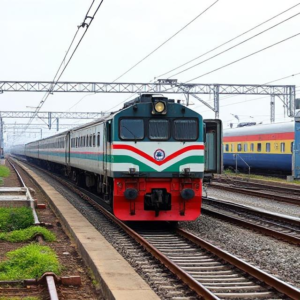Indian Railways and International Collaboration refers to the partnerships and agreements that India has with other countries to improve its railway systems, exchange technology, and work together on various railway projects. These collaborations help India upgrade its infrastructure, learn from other countries’ experiences, and adopt best practices in railway development. Let’s break this down in simple terms:

1. Collaboration with Other Countries for Railway Technology Sharing
Indian Railways works with several countries to share railway technologies, best practices, and knowledge. This helps in modernizing the railway system and improving efficiency, safety, and sustainability. Here’s how it works:
a. Learning from Global Experts
- Indian Railways collaborates with countries that have advanced rail systems, like Japan, Germany, and Russia, to learn from their technology and management.
- These countries help train Indian engineers, provide technical expertise, and even assist in designing and implementing new technologies for trains, tracks, and stations.
b. Sharing Advanced Technologies
- Indian Railways adopts cutting-edge technologies that other countries use for things like high-speed trains, automated signaling, and safety systems.
- For example, Japan is a leader in high-speed trains, and India has collaborated with Japan to bring Shinkansen (bullet trains) technology to India.
c. Modernizing Infrastructure
- Through these collaborations, Indian Railways gets access to technologies like automatic train protection, advanced train control systems, and smart railway stations.
- Other countries also help India improve its railway safety, track maintenance, and train operations.
d. Knowledge Exchange
- India also shares its own experiences, especially in managing a vast railway network like the one in India, with other countries that are developing their rail systems.
- This exchange of knowledge benefits both sides and leads to improvements in railway management and technology.
2. Railway Projects Involving International Partnerships
In addition to sharing technology, Indian Railways has been involved in various international railway projects in partnership with other countries. These collaborations bring together the strengths of multiple nations to complete big railway projects and solve challenges.
a. High-Speed Rail Projects (Like the Bullet Train)
- Japan and India have collaborated to launch the Mumbai-Ahmedabad High-Speed Rail Corridor (bullet train project), which is a major project involving Shinkansen technology.
- Japan has provided technical expertise, training, and funding for this project.
- The aim is to bring high-speed trains to India, reducing travel time between cities and boosting economic growth.
b. India-Russia Collaboration on Railways
- India and Russia have been working together on various railway projects, including track modernization and the building of railway stations.
- Russia has provided train locomotives, railway technology, and expertise in modernizing India’s rail network. Russia has also helped build railcars and rail tracks for Indian Railways.
c. India and China’s Rail Cooperation
- India and China have discussed collaborative projects involving railway technology and infrastructure development.
- China has helped India in building rail bridges and tunnels in challenging terrains, especially in northeastern India where the railway routes pass through mountainous regions.
d. International Financing and Funding
- Many railway projects in India receive funding or investment from international organizations like the World Bank, Asian Infrastructure Investment Bank (AIIB), and JICA (Japan International Cooperation Agency).
- These funds are used to improve India’s railway infrastructure, especially in terms of upgrading tracks, stations, and train technology.
e. Collaboration with European Countries
- Germany has partnered with Indian Railways to bring advanced rail technology, particularly in rail electrification, high-speed trains, and track management.
- France has helped in improving the Paris-Delhi railway link with electrification, safety measures, and signaling systems.
f. South Asia Regional Cooperation
- Indian Railways also works with neighboring countries like Bangladesh, Nepal, and Sri Lanka to improve cross-border railway networks.
- For example, India and Bangladesh have worked on creating rail links to improve trade and people-to-people connectivity.
- Nepal and India have also discussed building railways connecting both countries, which will help increase transportation and economic exchange.
g. The Trans-Asian Railway Network
- India is part of the Trans-Asian Railway Network, which is a project involving countries across Asia and Europe. The goal is to build a continuous railway line that connects India to Europe, passing through many countries.
- This network will improve trade and transportation between countries and help reduce transportation costs.
3. Benefits of International Collaboration for Indian Railways
Here are some of the benefits of working with other countries on railway projects:
a. Access to Cutting-Edge Technology
- International partnerships bring new technologies to Indian Railways, such as high-speed trains, automated systems, and improved safety measures.
b. Modernization of Infrastructure
- Collaboration helps India modernize its old railway systems and upgrade stations and tracks to meet international standards.
c. Economic Growth
- High-speed rail projects and new train services can help boost economic development by making transportation faster, cheaper, and more efficient.
- The partnerships also create jobs and improve trade links, benefiting both India and its international partners.
d. Knowledge and Skill Transfer
- International partnerships allow Indian engineers, workers, and managers to learn from experts in other countries. This knowledge transfer helps improve the overall capabilities of the Indian railway workforce.
e. Improved Regional Connectivity
- Working with neighboring countries on cross-border railway links improves regional trade, tourism, and cultural exchanges. It also strengthens relationships between India and its neighbors.
Conclusion
International collaboration plays an important role in the growth and modernization of Indian Railways. By working with countries like Japan, Russia, Germany, and Bangladesh, India can access advanced technology, expertise, and funding to improve its railway system. These partnerships help bring high-speed trains, modern safety systems, and upgraded infrastructure to Indian Railways. Additionally, international projects improve regional connectivity, boost economic growth, and enhance trade across borders, making rail travel safer, faster, and more efficient.
Keywords: Indian Railways, Railway











